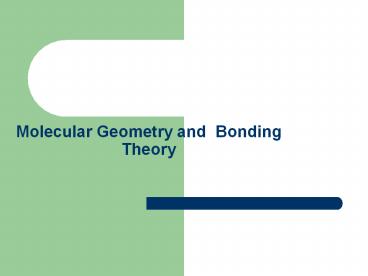Molecular Geometry and Bonding Theory - PowerPoint PPT Presentation
1 / 29
Title:
Molecular Geometry and Bonding Theory
Description:
VSEPR- Valence-Shell-Electron-Pair-Repulsion model- predicts geometry based upon e s around the central atom. Principles of the VSEPR theory Electrons are kept ... – PowerPoint PPT presentation
Number of Views:100
Avg rating:3.0/5.0
Title: Molecular Geometry and Bonding Theory
1
Molecular Geometry and Bonding Theory
2
Molecular Geometry
- Molecular Geometry- general shape of a molecule
as determined by the relative position of the
nuclei. - The geometry and size of a molecule helps to
determine its chemical behavior. - VSEPR- Valence-Shell-Electron-Pair-Repulsion
model- predicts geometry based upon es around
the central atom.
3
Principles of the VSEPR theory
- Electrons are kept as far away from one another
as possible minimizing e pair repulsions - Electron pairs are considered as being bonding or
non-bonding (lone pairs)
- A multiple bond counts as a single bonding pair
- Electron pair geometry is described by the
regions of es around the central atom - Molecular geometry is a consequence of electron
pair geometry.
4
Predicting Structures VSEPR
- Derive the Lewis Structure to the form AXmEn
- A central atom
- X atoms bonded to the central atom
- E lone pairs of es on the central atom
- M of bonded atoms
- N of lone pairs
5
Electron Geometry Linear
- Example
- Electron and Molecular Geometry Linear
- Bond angles 180
- Sp Hybrid
- Non-polar
6
More Examples AX2
7
Electron Geom. Trigonal Planar
- Molecular Geom. Trigonal Planar
- bond angles exactly 120 non-polar
- Bent bond angles aprox 120 polar molecule
- Sp2 hybridized
8
Electron Geom.Trigonal Planar
- Molecular Geometry AX3 (3BP or 2BP 1LP) ex.
3bp NO3-
ltgt
9
Examples Cont. 3bp
- BF3 ltgt
ltgt
10
Examples Cont. 2bp 1 lp
- Ex O3 (ozone)
11
Electron Geom. Tetrahedral
- Molecular Geom. Tetrahedral bond angles exactly
109.5 non-polar molecule, Trigonal pyramidal bond
angles aprox. 109.5 polar molecule, Bent bond
angles aprox. 109.5 polar molecule - Sp3 hybridized
12
Molecular Geometry AX4 4BP or (3BP 1LP) or
(2BP 2LP)
- Electron Geometry AX4Tetrahedral
13
Example
- BrO3F, Perbromyl fluoride
14
Molecular Geometry AX3E1Trigonal Pyramidal
15
Example
- NF3, Nitrogen trifluoride
16
Molecular Geometry AX2E2Bent/Angular
17
Example
ClOF, Chlorosyl fluoride
- H2O, Water,
18
Electron Geom. Trigonal Bypyramidal
- Mol. Geom. Trigonal Bypyramidal bond angles ax.
exactly 108 deg. eq. exactly 120 deg. Non-polar,
See-Saw bond angles ax. aprox. 108 deg. eq.
aprox. 120 deg. Polar, T-shaped - bond angles ax.
aprox. 108 deg. No eq, Linear bond angle
exactly 180 non-polar. - All sp3d hybridized
19
Mol geo. Trigonal bipramidal
- AX5 5BP or (4BP 1 LP) or (3BP 2LP) or (2BP
3LP) - 5bp
20
Example
- PCl5(gas phase), Phosphorous pentachloride
21
Molecular GeometryAX4E1See-saw
- Example IF2O2-
22
Molecular GeometryAX3E2T-structure
- Example ClF3
23
Molecular GeometryAX2E3Linear
- Examole XeF2
24
Electron Geometry Octahedrial
- Mol geo. Octahedral bond angle exactly 90 -
non-polar, square pyramidal bond angle aprox
90- polar, square planar- bond angle exactly 90
non-polar - Sp3d2 hybridized
25
Molecular Geometry AX6Octahedral
- Example SF6
26
Molecular Geometry AX4E1Pyramidal Planar
- Example XeOF4
27
Molecular Geometry AX4E2Square Planar
- Example XeF4
28
Bond Angles
- Non-bonding pairs of es take up more space (att.
by one nucli) than bonded e pairs - Double and triple bonds take up more space than
single bonds (more es) - Volume occupied lone pairs gt triple bonds gt
double bonds gt single bonds
29
Forces
- Non-bonding pairs exert repulsive forces on
adjacent e pairs and compress angles - Multiple bonds also exert repulsive forces and
compress angles































